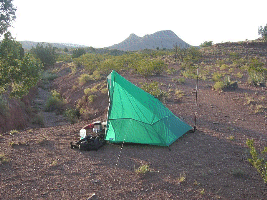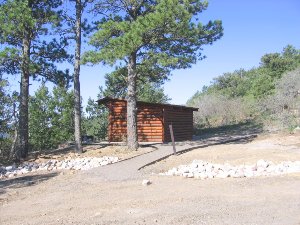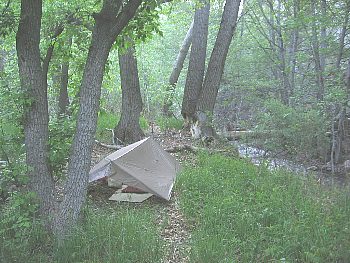Camping
Like the PCT and CDT,
the Grand Enchantment Trail supports a mostly primitive camping experience.
 |
| Chihuahuan
desert campsite |
No
habitable overnight lean-tos, huts, or hiker shelters occur along the route, and
although you may come across the occasional backcountry shanty, most would be
unsuitable for camping. Forest Service campgrounds are located sporadically between
the route's termini. Most are located near roads and are aimed primarily at car
campers. Now and then you may find yourself drawn in by the social atmosphere
at these places, or the creature comforts of a picnic table and bathroom. Usually,
though, you'll be camping in the woods. Or the desert. By a babbling creek, perhaps.
Or beneath a lone juniper tree. Established campsites with fire rings can be nice
when you find them, but otherwise the route is a treasure trove of pristine ground
just waiting for you to throw down a bedroll and stretch out for a restorative
night's slumber beneath the stars. Few camping restrictions exist on the ample
public lands along the G.E.T. Just be sure to camp far enough away from critical
water sources so that wildlife and stock animals feel secure in visiting them
during the night, and do verify that you're indeed on public land open to camping
and not in a restricted area (such as private land without landowner permission)
where camping is not allowed.
 |
| Capilla
Peak Campground picnic shelter, Manzano Mtns |
The
G.E.T. topo mapset highlights
some of the more noteworthy camping spots along the route. As do the guidebook
descriptions.
Equipment
Although
starry nights tend to be the rule, you should carry shelter with you along the
entire route. Not only will this keep you dry in the event of rain, snow, or the
very real chance of overnight dew, it can also keep you much warmer and less distracted
by shielding you from wind. A lightweight tarp is often a good choice for
thru-hikers, or you may want to carry an ultralight 3 season tent to keep
any insects and moths at bay. A full-coverage tent can be especially useful during
summer and fall hikes along the route's desert segments, when warm temperatures
and recent monsoon rains can create a sporadic abundance of scorpions.
In selecting a shelter for use on the G.E.T., focus primarily on minimizing its
weight and packed size, and on simplicity of set-up.
In
addition, consider carrying:
-
Thin-gauge titanium tent stakes for easier purchase and less flexing in
hardpan desert soils. Avoid the "ultralight" varieties, which bend like
aluminum stakes.
- A
lightweight, full coverage ground sheet, especially when tarping, to reduce
exposure to spines and burrs, and any insects
on the ground (ants or, especially in desert washes, possible scorpions).
- Inflatable
mattress vs. foam pad - you'll need to be more careful when selecting campsites
if carrying the former, but in my experience it is certainly possible to do so
without having a puncture. Carry an air mat inside your pack only, and
bring a patch kit for peace of mind. A half or three-quarter length inflatable
mattress can be easier to protect from puncturing spines, needles, cones and twigs
than can a full-length mat, reducing the need to preen the ground beforehand (or
selecting ideal campsites) and so simplifying camp setup.
And
as a side note:
A
somewhat delicate issue, but when it comes to visiting the bushes (whether in
camp or not), please keep in mind that soils along a route such as the GET tend
to be thin, sandy or hardpan, and relatively inorganic. Toilet paper in particular
can be very slow to degrade and difficult to bury at sufficient depth to prevent
its eventual resurfacing. Packing out all toilet paper is therefore strongly encouraged,
and is in fact a painless act when carrying a spare, gallon-size zipper-lock bag
as part of one's toilet kit between each town stop. Use of an ethyl alcohol-based
hand sanitizer gel as a final step is normally standard procedure anyway, and
does away with any concerns related to upholding good Leave No Trace practice
in this case.
 |
| Tarping
along Whitewater Creek, Gila NF |





